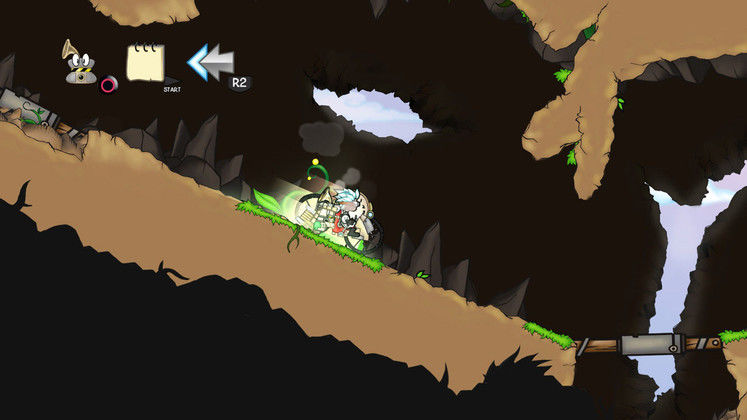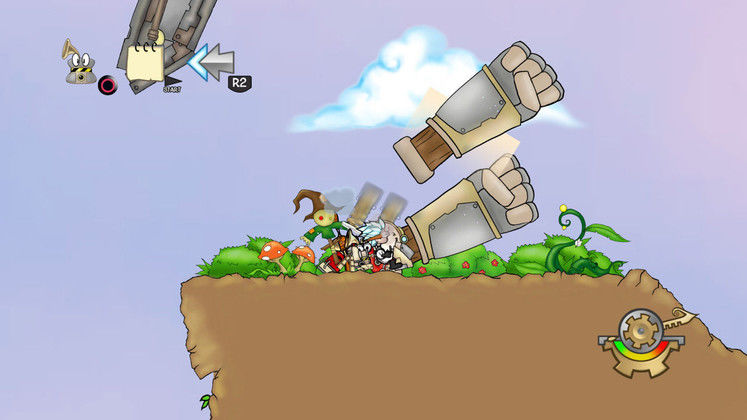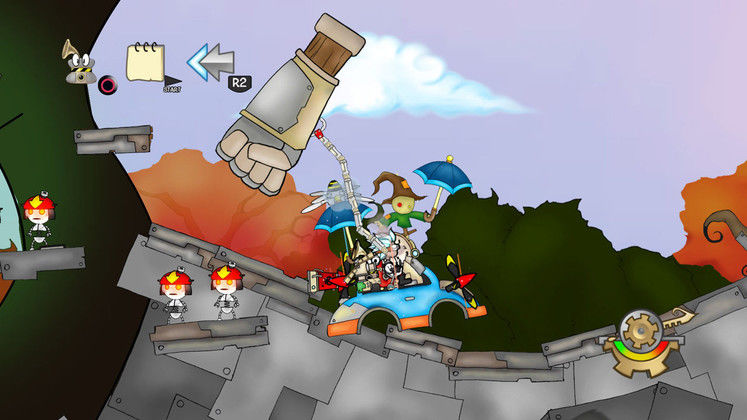Looking back at Stickmen Studios's past releases, two things are immediately clear. The person in charge of naming the games is inspired with titles such as Dragon Master: Spell Caster and Kung Fu Funk: Everybody is Kung Fu Fighting littering the studio's portfolio. The other realisation is that, despite Doc Clock: The Toasted Sandwich of Time's many flaws, it's the best game from the developers yet. That's a distinctly questionable praise, however.
 |
| There's a lot of sliding down hills in this game |
In Doc Clock: The Toasted Sandwich of Time, you play as toasted sandwich fan Doc Clock. Rather than going out to buy a toasted sandwich maker, he attempts to make one himself. It all goes horribly wrong and his pet cat is turned into a cactus. So the Doc decides to build a time machine so he can go back in time and stop the terrible event from occurring. Doc Clock isn't very bright so he ends up going forward into time to a land full of robots and obstacles. Worst of all, the time machine has been damaged and scattered across the land. It sounds weird and that's because it is.
It gets even weirder when you consider that the Doc also has a talking storage container called Sack who likes to regularly berate and insult the clumsy doctor. There was the potential for some entertaining exchanges but for the most part, I found myself skipping past the lines as they far too frequently repeated themselves. There was also that constant sense that the game thought it was being smarter than it was. This carries on into the actual mechanics and puzzles.
Across the different landscapes (comprising of Forest, Ice and Fire themes), Doc Clock must travel either by foot or vehicle. These means of transportation are built by combining different items found along the way. For the first few levels, it's mostly a matter of building bridges by combining planks and boxes. This progresses to creating vehicles, starting with a basic car and resulting in flying and bouncing crafts.
 |
| You can smash through giant fists but you can't step over small boulders |
On paper, it sounds like a fun concept. It is, potentially. There's a lot of flexibility in terms of how to build the vehicles. Frequently, you'll be given a couple of wheels, a propeller, an umbrella and something to form the base of the vehicle such as a fridge or sofa. The angle of the placement of each part plays a crucial role. The vehicle will travel in the direction that the propeller is pointed, for instance, while an umbrella or hang glider affects how it flies. Later levels offer rockets and springs which further mix things up. The problem lies in the physics engine behind Doc Clock: The Toasted Sandwich of Time. It feels random, reacting differently than expected at certain points. This invokes a lot of trial and error in your quest to succeed, even more so during later puzzles in which timing becomes crucial.
There is a saving grace that encourages experimental play: the Time Slider. Doc Clock might struggle to travel in time for any great length but there is enough power left in the device to go back short periods of time, thus allowing him to reverse his puzzle based decision and try again. It's a tool that's vital to ensuring you don't go mad with frustration and annoyance, and risk trying something different while creating a vehicle. I found some stages obtuse enough that I spent more time undoing my mistakes than actually playing in 'real-time'.
While the puzzles do get rather bland and predictable, the main culprit in frustration is the awkward control system. Doc Clock: The Toasted Sandwich of Time offers Move support but I wasn't able to use this. Instead, I was left with the clumsiness of the regular controller, presumably channeling just how clumsy Doc Clock really is.
 |
| Mary Poppins hadn't aged well |
Doc Clock has a robotic arm that picks up all the items he needs to make things with or place into his Sack. This robotic arm has curious restrictions in that it's able to lift fridges but it's not able to pull out of the way levers. You use the right analogue stick to move the arm around then press R1 to grab the item. Hold in the right analogue stick and the item goes immediately to Sack. Rotation of the object is done with either L1 or L2. It doesn't feel intuitive. Rotating makes you want to tap one L button and one R button in order to rotate the relevant direction, instead you end up dropping the object. Using the right stick to move around makes it cumbersome to highlight the right item when there are many options available, such as once a vehicle has been created. You can't even pick up a vehicle as a whole, restricted to individual pieces instead. Navigating Sack's contents is a matter of tapping up or down with the right analogue stick but, again, it's clumsy and tends to lead to moving the arm around rather than conveniently browsing Sack.
Such illogical game decisions undermine what could have been a fun distraction. Doc Clock: The Toasted Sandwich of Time isn't long by any means, weighing in at around 5-6 hours, with replayability in the form of finding a toasted sandwich in each stage, but there are still too many moments where you'll question why certain features weren't implemented. Even relatively minor things like the inability to jump will grate, let alone more major concerns such as the control system. What could have been something rather special is simply a scattering of nice ideas, awkwardly actioned.
TOP GAME MOMENT
Finally successfully traversing a gap in a flying car after many problems with getting things at just the right angle.




